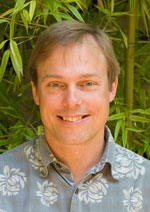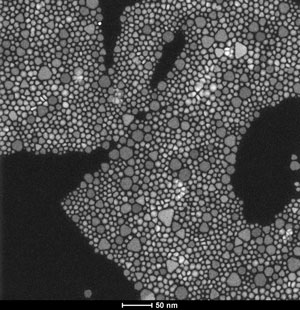Eugene, OR | February 28th, 2012
Using high-precision microscopy and X-ray scattering techniques, University of Oregon researchers have gained eye-opening insights into the process of applying green chemistry to nanotechnology that results in high yields, improves efficiency and dramatically reduces waste and potential negative exposure to human health or the environment.

That accomplishment, he said, has important implications. The use of lower concentrations of the precursor that forms the nanoparticles virtually eliminates the ability of nanoparticles to aggregate together and thus prevents variations of sizes of the desired end product.

He also summarized his lab's use of chemically modified grids (Smart Grids) in transmission electron microscopy to study how nanoparticles are shed from common objects such as silverware and copper jewelry -- findings that were detailed in the journal ACS Nano in October. They studied the transformation of silver nanoparticles coated on Smart Grids as well as the common objects and found that all forms produce smaller silver nanoparticles that could disperse into the environment, especially in humid air, water and light -- and likely have been doing that throughout time without any known health ramifications.
"There may be many beneficial applications to nanotechnology, but they are only beneficial if the net benefits outweigh the deleterious implications for human health and the environment," said Hutchison, who holds the Lokey-Harrington Chair in Chemistry at the University of Oregon.
These new monitoring and measuring techniques, he said, are vital to help understand what modifications are possible in the processes that grow nanoparticles for a desired product. Using green chemistry, he added, can help assure both efficiency and stability of a product, which, in turn, will lower the risk of unwanted environmental or harmful human-health consequences.
Hutchison is co-author of "Green Nanotechnology Challenges and Opportunities," a white paper published by the American Chemical Society's Green Chemistry Institute, and the National Research Council report, "A Research Strategy for Environmental, Health, and Safety Aspects of Engineered Nanomaterials." He also was the founding director of the Safer Nanomaterials and Nanomanufacturing Initiative (SSNI) of the Oregon Nanoscience and Microtechnologies Institute (ONAMI), a state signature research center.
About University of Oregon
The University of Oregon is among the 108 institutions chosen from 4,633 U.S. universities for top-tier designation of "Very High Research Activity" in the 2010 Carnegie Classification of Institutions of Higher Education. The UO also is one of two Pacific Northwest members of the Association of American Universities.
